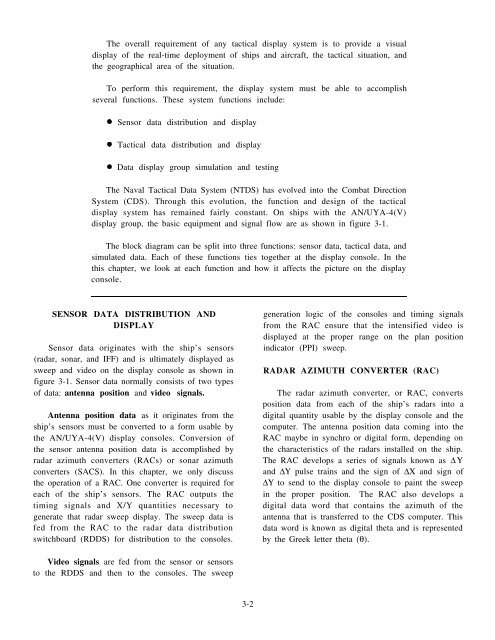nonresident training course - Historic Naval Ships Association
nonresident training course - Historic Naval Ships Association
nonresident training course - Historic Naval Ships Association
You also want an ePaper? Increase the reach of your titles
YUMPU automatically turns print PDFs into web optimized ePapers that Google loves.
The overall requirement of any tactical display system is to provide a visual<br />
display of the real-time deployment of ships and aircraft, the tactical situation, and<br />
the geographical area of the situation.<br />
To perform this requirement, the display system must be able to accomplish<br />
several functions. These system functions include:<br />
Sensor data distribution and display<br />
Tactical data distribution and display<br />
Data display group simulation and testing<br />
The <strong>Naval</strong> Tactical Data System (NTDS) has evolved into the Combat Direction<br />
System (CDS). Through this evolution, the function and design of the tactical<br />
display system has remained fairly constant. On ships with the AN/UYA-4(V)<br />
display group, the basic equipment and signal flow are as shown in figure 3-1.<br />
The block diagram can be split into three functions: sensor data, tactical data, and<br />
simulated data. Each of these functions ties together at the display console. In the<br />
this chapter, we look at each function and how it affects the picture on the display<br />
console.<br />
SENSOR DATA DISTRIBUTION AND<br />
DISPLAY<br />
Sensor data originates with the ship’s sensors<br />
(radar, sonar, and IFF) and is ultimately displayed as<br />
sweep and video on the display console as shown in<br />
figure 3-1. Sensor data normally consists of two types<br />
of data: antenna position and video signals.<br />
Antenna position data as it originates from the<br />
ship’s sensors must be converted to a form usable by<br />
the AN/UYA-4(V) display consoles. Conversion of<br />
the sensor antenna position data is accomplished by<br />
radar azimuth converters (RACs) or sonar azimuth<br />
converters (SACS). In this chapter, we only discuss<br />
the operation of a RAC. One converter is required for<br />
each of the ship’s sensors. The RAC outputs the<br />
timing signals and X/Y quantities necessary to<br />
generate that radar sweep display. The sweep data is<br />
fed from the RAC to the radar data distribution<br />
switchboard (RDDS) for distribution to the consoles.<br />
generation logic of the consoles and timing signals<br />
from the RAC ensure that the intensified video is<br />
displayed at the proper range on the plan position<br />
indicator (PPI) sweep.<br />
RADAR AZIMUTH CONVERTER (RAC)<br />
The radar azimuth converter, or RAC, converts<br />
position data from each of the ship’s radars into a<br />
digital quantity usable by the display console and the<br />
computer. The antenna position data coming into the<br />
RAC maybe in synchro or digital form, depending on<br />
the characteristics of the radars installed on the ship.<br />
The RAC develops a series of signals known as ∆Υ<br />
and ∆Υ pulse trains and the sign of ∆Χ and sign of<br />
∆Υ to send to the display console to paint the sweep<br />
in the proper position. The RAC also develops a<br />
digital data word that contains the azimuth of the<br />
antenna that is transferred to the CDS computer. This<br />
data word is known as digital theta and is represented<br />
by the Greek letter theta (θ).<br />
Video signals are fed from the sensor or sensors<br />
to the RDDS and then to the consoles. The sweep<br />
3-2

















